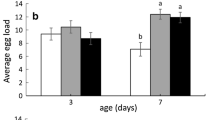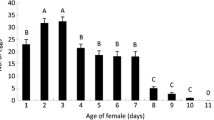Abstract
The biology and behaviour ofTetrastichus sesamiae Risbec, a pupal endoparasitoid ofMaruca testulalis Geyer, were studied under laboratory conditions. Most adults emerged from the host pupae between 08.00 h and 09.00 h and mating and oviposition started almost immediately. Both ♂♂ and ♀♀ mated repeatedly, and each ♀ could lay eggs for up to 6 days and in up to 5 host pupae. Progeny production ranged from 0–263 offspring per ♀ and adult longevity was from 4.3–13.9 days. The quality of food available to the adults was a major factor influencing progeny production, and longevity. The species was capable of parasitizing and completing development on pupae of such other major Lepidopteran crop pests asChilo partellus Swinhoe,Busseola fusca Fuller,Eldana saccharina Wlk andSpodoptera exempta Wlk, an important finding for biological control of these pests under intercropped agro ecosystems. Apart from parasitism, ♀♀ ofT. sesamiae also caused considerable mortality by stinging, and presumably paralyzing, host pupae without ovipositing.
Résumé
La biologie et le comportement deTetrastichus sesamiae Risbec, parasitoïde endophage des pupes deMaruca testulalis Geyer, ont été étudiées dans les conditions de laboratoire. La plupart des adultes émergent des pupes hôtes entre 08.00 et 09.00 h et l'accouplement et la ponte débutent presque immédiatement. Les ♂♂ et les ♀♀ s'accouplent plusieurs fois et chaque femelle peut pondre durant 6 jours dans 5 pupes hôtes au maximum par jour. La descendance varie de 0 à 263 descendants par femelle et la longévité des adultes varie de 4,3 à 13,9 jours. La qualité de la nourriture disponible pour les adultes est le facteur principal influençant la descendance et la longévité. L'espèce est capable de parasiter et de se développer complètement sur les pupes d'autres Lépidoptères ravageurs majeurs des cultures, tels queChilo partellus Swinhoe,Busseola fusca Fuller,Eldana saccharina Wlk etSpodoptera exempta Wlk, résultat important pour la lutte biologique contre ces ravageurs dans des agroécosystèmes à polyculture. Indépendamment du parasitisme, les femelles deT. sesamiae entraînent aussi une mortalité considérable en perforant et probablement en paralysant les pupes hôtes sans ponte.
Similar content being viewed by others
References
Okeyo-Owuor, J.-B. & Agwaro, P. O. — 1988. A simple trap for samplingMaruca testulalis (Geyer) (Lepidoptera, Pyralidae) pupae on cowpea crop. —Insect Sci. Appl. (in press).
Seshu Reddy, K. V. — 1985. Relative susceptibility and resistance of some sorghum lines to stem-borers in Western Kenya. —Insect Sci. Appl., 6, 401–404.
Author information
Authors and Affiliations
Rights and permissions
About this article
Cite this article
Okeyo-Owuor, J.B., Oloo, G.W. & Agwaro, P.O. Bionomics ofTetrastichus sesamiae [Hymenoptera: Eulophidae], a pupal endo-parasitoid ofMaruca testulalis [Lepidoptera: Pyralidae] . Entomophaga 36, 417–423 (1991). https://doi.org/10.1007/BF02377947
Received:
Accepted:
Issue Date:
DOI: https://doi.org/10.1007/BF02377947




